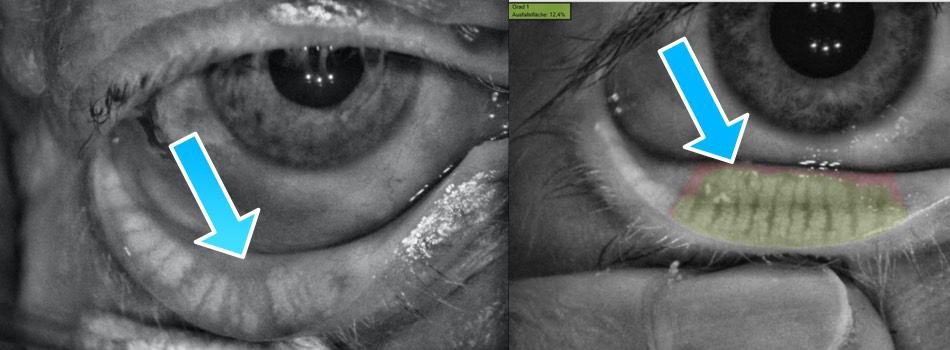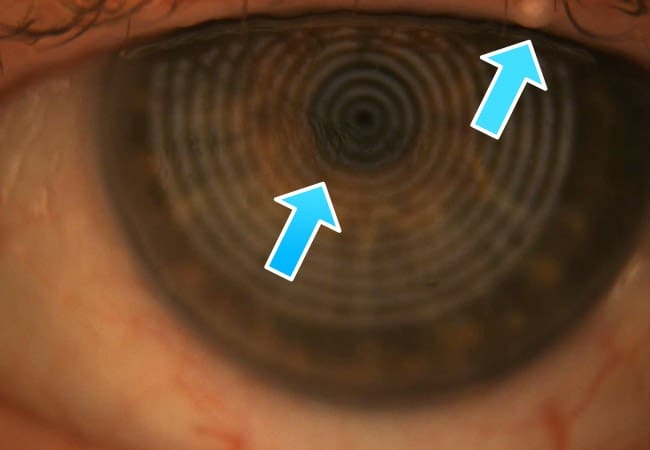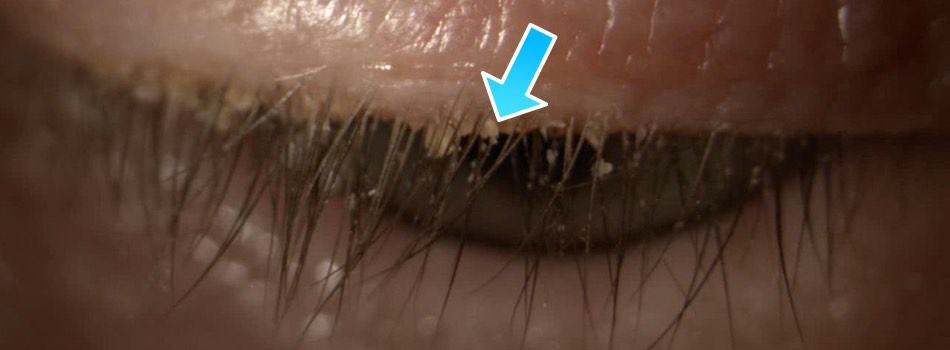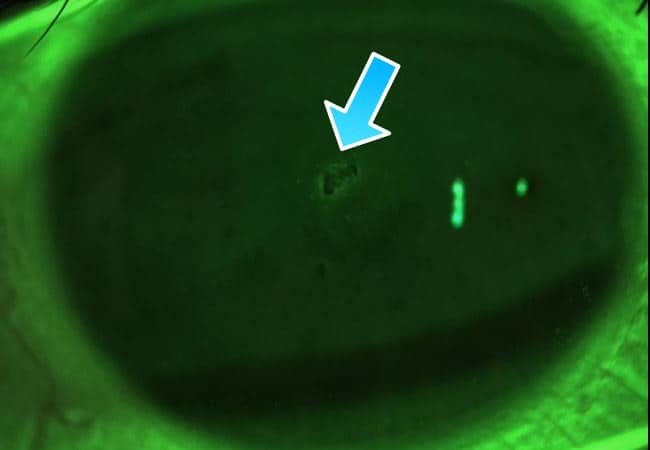There are a lot of causes why your eyes water all the time. Here in this article, you can learn what the most common ones are with examples and pictures. Keep in mind most of these causes are detected with special equipment and a professional in your field.
So seek advice of your ophthalmologist, optician or optometrist to get your eyes checked individually. This article provides just general information.
Teary eyes can be caused by the several topics in the list down below:
- Changed shape of the eyelids due to surgery or injury
- Infections
- Insufficient secretion by your meibomian glands
- Allergies
- Blocked tear duct
- Ingrown eyelashes
- Changed wetting of your cornea
- Exposure to chemicals
- Certain medications
- Certain preservatives in your eye drops
- Corneal infiltrates
Let us start with the most common teary eye causes.
Insufficient Secretion by Your Meibomian Glands – and What You Can Do About It
A lot of people are plagued by Meibom Gland Dysfunction aka MGD. Those glands sit in your upper and lower eyelids and produce an oily film to provide you with a stable tear film. However, in a lot of cases, the function of this gland is inhibited. The causes of therefore are broad.
- Inflammation of the glands (Meibomitis)
- Mites in the meibomian gland and eyelash area (Demodex folliculorum)
- Atrophy of meibomian glands
- Clogged Meibom glands
Some causes are easier to spot than others for your eye care professional. Of course, multiple causes come together as well. For example atrophy of the meibomian glands can be easily spotted with an infrared scan (meibography).

Atrophy of those glands is generally speaking more found in the older part of the population. What happens is the oily part of the tear film is reduced the fewer glands you have. This is known as an evaporative dry eye and really common. The tear film gets unstable and dries up here and there. Your eye overcompensates this condition with more tears.

In such a case lipid sprays can improve the situation. Because as the oily part gets supplemented your tear film will get more stable again.
There are also alternative methods to improve the way how your glands work. One is warm compresses that get applied best daily to improve the secretion of the glands. In a lot of cases, this is very effective when the glands are clogged up.
Because when the glands are clogged up no oily secretion can get on your eye and the result will be of course teary eyes because of the missing part of your tear-film your eyes will dry up and your eyes overcompensate again with more tears.
When it comes to the mites Demodex folliculorum and Demodex brevis the lashes oftentimes change the way they grow a little. Oftentimes these parts get underdiagnosed. In Germany for example opticians can speak about a reasonable suspicion but we can not diagnose something.
This is the work of ophthalmologists. However, when it comes to mites oftentimes there will be strong signs.
- Chronic blepharitis
- Flaky deposits in your eyelashes
- Normal cleaning and lid hygiene does not seem to work
If those signs come up ophthalmologists often use products that are based on tea tree oil. But be careful with this and pay attention to the instructions because those products can lead to irritated eyes if not used correctly.

Preservatives in Your Eye Drops Can Make Your Tear Film Unstable Too and Lead to Teary Eyes
It sounds odd but some eye drops are not beneficial when used for a long time. Because with the wrong ingredients in the eye drops your tear film can get unstable. The result will be watering eyes. Look out for the following preservatives. They could influence your tear film or eyes in general if used over a long period of time.
- Benzalkonium Chloride
- Cetrimide
- Chlorobutanol
- Chlorhexidine
- Polyhexanide
- Polyquad
Not all of this mentioned in ingredients are preservatives but they can lead to problematic outcomes like allergies that lead to teary eyes.
When people switched from eye drops with preservatives in them to preservative-free eye drops the severity of their problems could be reduced oftentimes in three weeks. You can read more about this article here. My experience affirms this info. But the time for improvement can vary a lot from person to person.
For Some it just takes a couple of days to see the tear film gets more stable. But for most people the change takes place in a couple of weeks.
Ingrown Eye Lashes Lead to Irritated Eyes
In some, mechanical stress like an ingrown eyelash that rubs on your eye can lead to teary eyes. They can be removed by your opthalmologist or optical doctor.
Problems With the Wetting of Your Cornea
In some cases when the wetting of your eyes is unstable due to mechanical irritated spots or spots that often dried up you can experience teary eyes.
In the example below the wearer of contact lenses had problems with unstable vision and teary eyes for a few weeks. As I checked the eye I noticed a spot on the cornea that showed a conspicuous area when I used fluorescent to observe the eye.

In this case, the solution was to optimize the back surface of the contact lens and after a few days of wearing the new contact lens the cornea looked great again and the customer got relief of her eyes watering all the time.
What you can see in the picture are cell defects. Similar effects can come up if the patient sleeps with the eyes slightly open. Because if the eyes are slightly open when sleeping the eyes dry up a little and the cells on the cornea suffer.
Which is also not good for the tear film and can lead to irritated eyes. An easy solution to this problem is oftentimes a simple sleep mask. Because when the eyelids are closed by the light material of the sleep mask they close completely. Problems with open eyes during your sleep can be also made visible with fluorescent eye drops.
Why a Changed Shape of the Eyelids Can Lead to Excessive Tearing of Your Eyes
When surgery or injury changed the shaped of your eyelids permanently irritations of your eye can be a cause why your eyes water all the time. In such a case of course advice of your medical doctor is needed what the solution is to this problem.
In some cases, the eyelids do not align perfectly with the eyeball anymore and an interspace arises where the eyeball should be covered by your eyelids to protect it against environmental influences. Oftentimes the eyes react again with excessive tearing on a windy day for example.
What Infections Have to Do With Excessive Tearing of Your Eyes?
When you have an infection in your eye of course you should go to an ophthalmologist to get your eyes checked. In a lot of cases with infections the secretion of your glands in your eyes are influenced. This means you will notice more secretion or even a changed secretion in color.
Oftentimes when this secretion dries up on your eyelids you can spot the color. When it turns green you should see an ophthalmologist.
Although inflammatory changes on your eyes surface are risk factors for infection, yet overt infection is not commonly seen clinically in the typical dry eye patient. (Srihari Narayanan 2013) If you want to read more about this topic use this link here.
Blocked Tear Duct
The tear duct is the spot where the tears drain off. If this duct is clogged the tears will have no other way than to water down your eyelids and cheeks. Your ophthalmologist can help you with this by opening the duct again.
Exposure to Chemicals
This does not happen daily in my optical shop but sometimes when I observe a perforated tear film in combination with teary eyes I ask my customers what they did the days before. In some cases, they worked with a certain cleaning agent which irritated the eye. In most cases, exposure to chemicals can be seen under the microscope (Slitlamp) 24 hours after the event.
However, this of course is highly dependable on the chemicals and the intensity of the exposure to them. In such a case the appointment for the refraction needs to be rescheduled. Because a teary eye will affect the outcome of the measurements negatively.
Allergies
If you have allergies you know how they can impact your nasopharyngeal zone. The snuffles influence you during the day and so can teary eyes with an allergy. What you experience with the snuffle is a change in secretion in your nose. This can happen with your eyes too. Depending on what medication you take to make this situation better you can experience more dry eye symptoms.
Corneal Infiltrates & Ulcers
If a foreign object sticks in your cornea it is called an infiltrate. Of course, such a cause can lead to excessive tearing. An ophthalmologist should definitely check your eye in such a case. If your cornea is infected and you experience reduced visual acuity, and you are more sensitive to light in combination with excessive tearing you should get your eyes checked too. The reason could be an ulcer.
This is a severe infections and should be treated immediately.
All those information about teary eyes here in this article is not a substitute for professional advice. So if you think some of the mentioned causes may be true for you. Make an appointment with your eye care professional and talk to him about the things you read.
I wish you a great day.
